The Antimicrobial Powder Coating Market is estimated to be valued at USD 1.8 billion in 2025 and is projected to reach USD 5.4 billion by 2035, registering a compound annual growth rate (CAGR) of 11.5% over the forecast period.
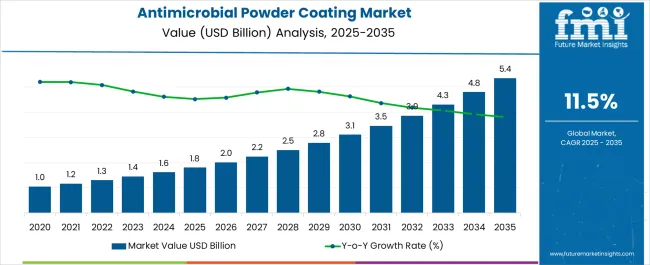
| Metric | Value |
|---|---|
| Antimicrobial Powder Coating Market Estimated Value in (2025 E) | USD 1.8 billion |
| Antimicrobial Powder Coating Market Forecast Value in (2035 F) | USD 5.4 billion |
| Forecast CAGR (2025 to 2035) | 11.5% |
The Antimicrobial Powder Coating market is witnessing strong growth, driven by the rising demand for surfaces that prevent microbial contamination in healthcare, food processing, and commercial environments. Increasing awareness regarding hygiene, infection control, and surface durability is accelerating adoption of antimicrobial coatings. Powder coatings provide long-lasting protection while being environmentally friendly, as they produce minimal volatile organic compounds compared to liquid coatings.
The integration of silver, copper, and other antimicrobial agents enhances the effectiveness of these coatings against bacteria, viruses, and fungi, making them suitable for high-touch and high-risk surfaces. Growing investments in hospitals, laboratories, and public infrastructure, along with stringent regulations for hygiene and sterilization, are further propelling market growth.
Advancements in coating technology, such as improved adhesion, durability, and surface finish, are expanding applications across diverse industries As organizations increasingly prioritize safe and hygienic environments, the market is expected to experience sustained growth, supported by technological innovation, regulatory compliance, and the rising demand for long-term antimicrobial protection.
The antimicrobial powder coating market is segmented by type, end-user industry, and geographic regions. By type, antimicrobial powder coating market is divided into Silver, Copper, Heavy Metals, Organic, and Natural. In terms of end-user industry, antimicrobial powder coating market is classified into Healthcare, Textiles, Electrical And Electronics, Food & Beverages, Building & Construction, and Others. Regionally, the antimicrobial powder coating industry is classified into North America, Latin America, Western Europe, Eastern Europe, Balkan & Baltic Countries, Russia & Belarus, Central Asia, East Asia, South Asia & Pacific, and the Middle East & Africa.
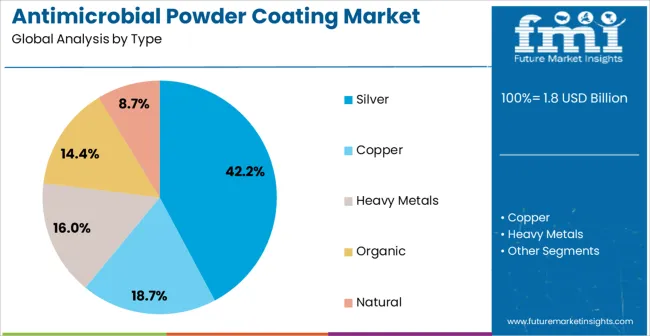
The silver type segment is projected to hold 42.2% of the market revenue in 2025, establishing it as the leading antimicrobial powder coating type. Its dominance is driven by silver’s proven antimicrobial efficacy against a broad spectrum of bacteria, viruses, and fungi. Silver-based coatings provide durable, long-term protection, which is critical for surfaces in healthcare, public facilities, and industrial environments.
The integration of silver into powder coatings allows for uniform dispersion and sustained antimicrobial activity without compromising surface performance or aesthetics. Enhanced resistance to corrosion, wear, and chemical exposure further reinforces adoption across high-traffic and high-contact areas. Manufacturers are leveraging silver coatings to meet stringent hygiene standards, regulatory requirements, and infection control protocols.
Growing awareness regarding healthcare-associated infections and contamination control is fueling demand, making silver the preferred choice among end users With ongoing research to optimize silver particle size, dispersion, and longevity in coatings, this segment is expected to maintain its market leadership, supported by widespread adoption in healthcare and other critical sectors.
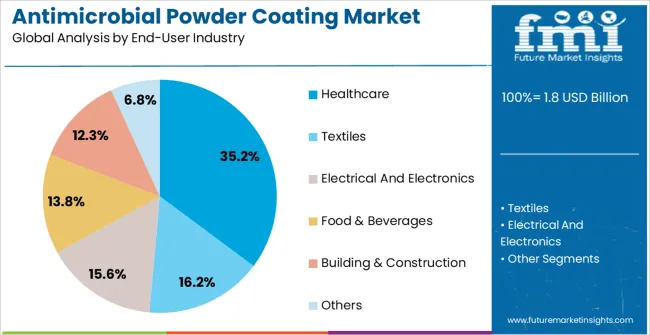
The healthcare end-user industry segment is expected to account for 35.2% of the market revenue in 2025, making it the leading end-use industry. Its growth is driven by the increasing need to prevent infections and maintain sterile environments in hospitals, clinics, laboratories, and pharmaceutical facilities. Antimicrobial powder coatings are being deployed on medical equipment, furniture, high-touch surfaces, and infrastructure components to reduce microbial contamination and enhance patient safety.
Regulatory mandates, hygiene protocols, and infection prevention initiatives are further reinforcing the adoption of these coatings in healthcare facilities. The ability to provide durable, low-maintenance, and environmentally friendly antimicrobial protection has strengthened their market position.
Growing investments in healthcare infrastructure and the expansion of hospital networks in emerging economies are boosting demand for antimicrobial coatings As infection control remains a top priority globally, the healthcare segment is expected to continue driving market growth, supported by technological advancements, regulatory compliance, and increasing awareness of the benefits of antimicrobial powder coatings.
Antimicrobial powder coating is used to protect a surface or material from being attacked by bacteria or fungi. Antimicrobial powder coating is typically applied as dry powder over a surface. High strength, durability, aesthetics, corrosion resistance and easy application are among the desired characteristics of antimicrobial powder coatings.
Antimicrobial material used for powder coating can be bifurcated into three categories such as natural, organic and inorganic materials. Inorganic materials dominate the global demand for antimicrobial powder coating material owing to higher efficiency than natural and organic materials. Inorganic materials primarily comprise of silver, copper and other heavy metals. Silver is the most dominant product segment for antimicrobial powder coatings owing to its high bio-compatibility.
Antimicrobial powder coating is mainly applied on products which frequently come in human contact to protect against infections and diseases. Major end user industries for antimicrobial powder coating include food, healthcare, furniture, textile, construction and electronics among several others. Indoor air quality applications dominate the global demand for antimicrobial coatings and the trend is expected to continue during the forecast period. Construction industry is also expected to be among the most lucrative application segment in the near future.
Increasing air pollution leading to several health hazards has been a major factor driving demand for antimicrobial powder coatings. Owing to growing awareness and concern over these air pollution related issues, indoor air quality is expected to be the fastest growing application segment during the forecast period. High bio-compatibility and several environmental benefits such as absence of VOC (Volatile Organic Compound) are among major factors driving demand for antimicrobial powder coating. Demand for antimicrobial powder coating for healthcare application is anticipated to surge in the near future primarily owing to increased research and development in the application segment. Moreover, food and healthcare are among major end user segment for antimicrobial powder coating hence, the industry is characterized by presence of stringent government regulations. Increasing number of regulations in the industry has been a major factor restraining growth of antimicrobial powder coating market. Growth in construction activities is among other major factors driving demand for antimicrobial coatings. Increasing research and development activities is expected to offer huge growth opportunity in the market.
North America dominates the global demand for antimicrobial powder coatings and the trend is anticipated to continue during the forecast period. North America is also anticipated to be the fastest growing region for antimicrobial powder coating market. Increasing demand for healthcare and food preserving applications are expected to drive market growth in North America. Demand for antimicrobial coatings is profoundly dependent on the demand for various consumer goods such as sanitary, tableware and storage bins among several others. Hence growing disposable income and GDP growth rate are among major growth determinants for market growth. Therefore, emerging economies such as India, China and Brazil are anticipated to offer huge growth opportunity for market growth during the forecast period.
Antimicrobial powder coating market is driven by innovation and major players compete by increasing their research and development activities to meet the dynamic demand of end consumers. The market is moderately concentrated and is characterized by high degree of competition. Major players in the antimicrobial powder coating market include AkzoNobel NV, Diamond Vogel Paints, Nippon Paint Co. Ltd., RPM International, PPG Industries Inc., Sono-Tek Corporation, Sherwin-Williams Company, Dow Microbial Control and Royal DSM N.V. among others.
The research report presents a comprehensive assessment of the market and contains thoughtful insights, facts, historical data, and statistically supported and industry-validated market data. It also contains projections using a suitable set of assumptions and methodologies. The research report provides analysis and information according to market segments such as geographies, application, and industry.
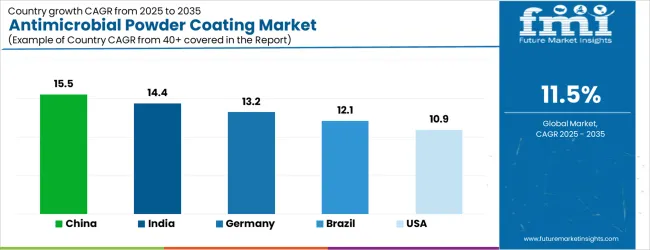
| Country | CAGR |
|---|---|
| China | 15.5% |
| India | 14.4% |
| Germany | 13.2% |
| Brazil | 12.1% |
| USA | 10.9% |
| UK | 9.8% |
| Japan | 8.6% |
The Antimicrobial Powder Coating Market is expected to register a CAGR of 11.5% during the forecast period, exhibiting varied country level momentum. China leads with the highest CAGR of 15.5%, followed by India at 14.4%. Developed markets such as Germany, France, and the UK continue to expand steadily, while the USA is likely to grow at consistent rates. Japan posts the lowest CAGR at 8.6%, yet still underscores a broadly positive trajectory for the global Antimicrobial Powder Coating Market. In 2024, Germany held a dominant revenue in the Western Europe market and is expected to grow with a CAGR of 13.2%. The USA Antimicrobial Powder Coating Market is estimated to be valued at USD 664.6 million in 2025 and is anticipated to reach a valuation of USD 664.6 million by 2035. Sales are projected to rise at a CAGR of 0.0% over the forecast period between 2025 and 2035. While Japan and South Korea markets are estimated to be valued at USD 95.5 million and USD 46.1 million respectively in 2025.
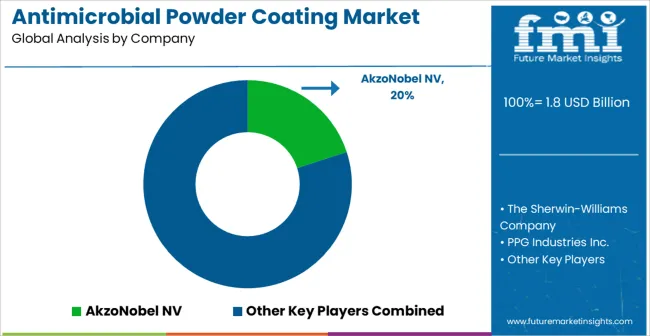
| Item | Value |
|---|---|
| Quantitative Units | USD 1.8 Billion |
| Type | Silver, Copper, Heavy Metals, Organic, and Natural |
| End-User Industry | Healthcare, Textiles, Electrical And Electronics, Food & Beverages, Building & Construction, and Others |
| Regions Covered | North America, Europe, Asia-Pacific, Latin America, Middle East & Africa |
| Country Covered | United States, Canada, Germany, France, United Kingdom, China, Japan, India, Brazil, South Africa |
| Key Companies Profiled | AkzoNobel NV, The Sherwin-Williams Company, PPG Industries Inc., Axalta Coating Systems, Berger Paints India Limited, Teknos Group, Diamond Vogel, IFC Coatings, and Thermaset Ltd |
The global antimicrobial powder coating market is estimated to be valued at USD 1.8 billion in 2025.
The market size for the antimicrobial powder coating market is projected to reach USD 5.4 billion by 2035.
The antimicrobial powder coating market is expected to grow at a 11.5% CAGR between 2025 and 2035.
The key product types in antimicrobial powder coating market are silver, copper, heavy metals, organic and natural.
In terms of end-user industry, healthcare segment to command 35.2% share in the antimicrobial powder coating market in 2025.






Our Research Products

The "Full Research Suite" delivers actionable market intel, deep dives on markets or technologies, so clients act faster, cut risk, and unlock growth.

The Leaderboard benchmarks and ranks top vendors, classifying them as Established Leaders, Leading Challengers, or Disruptors & Challengers.

Locates where complements amplify value and substitutes erode it, forecasting net impact by horizon

We deliver granular, decision-grade intel: market sizing, 5-year forecasts, pricing, adoption, usage, revenue, and operational KPIs—plus competitor tracking, regulation, and value chains—across 60 countries broadly.

Spot the shifts before they hit your P&L. We track inflection points, adoption curves, pricing moves, and ecosystem plays to show where demand is heading, why it is changing, and what to do next across high-growth markets and disruptive tech

Real-time reads of user behavior. We track shifting priorities, perceptions of today’s and next-gen services, and provider experience, then pace how fast tech moves from trial to adoption, blending buyer, consumer, and channel inputs with social signals (#WhySwitch, #UX).

Partner with our analyst team to build a custom report designed around your business priorities. From analysing market trends to assessing competitors or crafting bespoke datasets, we tailor insights to your needs.
Supplier Intelligence
Discovery & Profiling
Capacity & Footprint
Performance & Risk
Compliance & Governance
Commercial Readiness
Who Supplies Whom
Scorecards & Shortlists
Playbooks & Docs
Category Intelligence
Definition & Scope
Demand & Use Cases
Cost Drivers
Market Structure
Supply Chain Map
Trade & Policy
Operating Norms
Deliverables
Buyer Intelligence
Account Basics
Spend & Scope
Procurement Model
Vendor Requirements
Terms & Policies
Entry Strategy
Pain Points & Triggers
Outputs
Pricing Analysis
Benchmarks
Trends
Should-Cost
Indexation
Landed Cost
Commercial Terms
Deliverables
Brand Analysis
Positioning & Value Prop
Share & Presence
Customer Evidence
Go-to-Market
Digital & Reputation
Compliance & Trust
KPIs & Gaps
Outputs
Full Research Suite comprises of:
Market outlook & trends analysis
Interviews & case studies
Strategic recommendations
Vendor profiles & capabilities analysis
5-year forecasts
8 regions and 60+ country-level data splits
Market segment data splits
12 months of continuous data updates
DELIVERED AS:
PDF EXCEL ONLINE
Powder Coating Guns Market
Antimicrobial Nanocoatings Market Growth - Trends & Forecast 2025 to 2035
Antimicrobial HVAC Coating Market Size and Share Forecast Outlook 2025 to 2035
Antimicrobial Coil Coating Market Growth - Trends & Forecast 2025 to 2035
Antimicrobial Glass Powder Market Forecast and Outlook 2025 to 2035
Antimicrobial Hospital Textile Market Forecast Outlook 2025 to 2035
Antimicrobial Cap Fitters Market Size and Share Forecast Outlook 2025 to 2035
Antimicrobial Skincare Market Analysis - Size and Share Forecast Outlook 2025 to 2035
Antimicrobial Feed Additives Market Analysis - Size and Share Forecast Outlook 2025 to 2035
Antimicrobials Cosmetic Preserving market Size and Share Forecast Outlook 2025 to 2035
Coating Pretreatment Market Size and Share Forecast Outlook 2025 to 2035
Antimicrobial Packaging Ingredients for Food Packaging Market Size and Share Forecast Outlook 2025 to 2035
Powdered Cellulose Market Analysis - Size, Share, and Forecast Outlook 2025 to 2035
Antimicrobial-coated Medical Devices Market Size and Share Forecast Outlook 2025 to 2035
Coating Resins Market Size and Share Forecast Outlook 2025 to 2035
Coating Auxiliaries Market Size and Share Forecast Outlook 2025 to 2035
Powdered Soft Drinks Market Size and Share Forecast Outlook 2025 to 2035
Antimicrobial Wound Care Dressings Market Analysis - Size, Share, and Forecast Outlook 2025 to 2035
Antimicrobial Additives Market Analysis - Size, Share, and Forecast Outlook 2025 to 2035
Antimicrobial Car Care Products Market Size and Share Forecast Outlook 2025 to 2035

Thank you!
You will receive an email from our Business Development Manager. Please be sure to check your SPAM/JUNK folder too.
Chat With
MaRIA